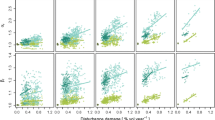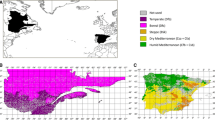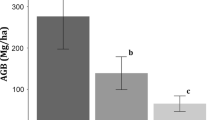Abstract
Biodiversity fosters the functioning and stability of forest ecosystems and, consequently, the provision of crucial ecosystem services that support human well-being and quality of life. In particular, it has been suggested that tree species diversity buffers ecosystems against the impacts of disturbances, a relationship known as the “insurance hypothesis”. Natural disturbances have increased across Europe in recent decades and climate change is expected to amplify the frequency and severity of disturbance events. In this context, mitigating disturbance impacts and increasing the resilience of forest ecosystems is of growing importance. We have tested how tree species diversity modulates the impact of disturbance on net primary production and the total carbon stored in living biomass for a temperate forest landscape in Central Europe. Using the simulation model iLand to study the effect of different disturbance regimes on landscapes with varying levels of tree species richness, we found that increasing diversity generally reduces the disturbance impact on carbon storage and uptake, but that this effect weakens or even reverses with successional development. Our simulations indicate a clear positive relationship between diversity and resilience, with more diverse systems experiencing lower disturbance-induced variability in their trajectories of ecosystem functioning. We found that positive effects of tree species diversity are mainly driven by an increase in functional diversity and a modulation of traits related to recolonization and resource usage. The results of our study suggest that increasing tree species diversity could mitigate the effects of intensifying disturbance regimes on ecosystem functioning and improve the robustness of forest carbon storage and the role of forests in climate change mitigation.



Similar content being viewed by others
References
Baeten L, Verheyen K, Wirth C et al (2013) A novel comparative research platform designed to determine the functional significance of tree species diversity in European forests. Perspect Plant Ecol Evol Syst 15:281–291. doi:10.1016/j.ppees.2013.07.002
Bengtsson J, Nilsson SG, Franc A, Menozzi P (2000) Biodiversity, disturbances, ecosystem function and management of European forests. For Ecol Manage 132:39–50
Bohn U, Gollub G, Hettwer C et al (2004) Karte der natürlichen vegetation Europe (Map of the natural vegetation of Europe) Maßtab (scale) 1:2500000. Bundesamt für Naturschutz (Federal Agency for Nature), Leipzig
Breiman L (2001) Random forests. Machine Learning 45:5–32
Canadell JG, Raupach MR (2008) Managing forests for climate change mitigation. Science 320:1456–1457. doi:10.1126/science.1155458
Cardinale BJ, Gross K, Fritschie K et al (2013) Biodiversity simultaneously enhances the production and stability of community biomass, but the effects are independent. Ecology 94:1697–1707
Cutler DR, Edwards TC, Beard KH et al (2007) Random forests for classification in ecology. Ecology 88:2783–2792
Déqué M, Somot S, Sanchez-Gomez E et al (2011) The spread amongst ENSEMBLES regional scenarios: regional climate models, driving general circulation models and interannual variability. Clim Dyn 38:951–964. doi:10.1007/s00382-011-1053-x
Duursma RA, Marshall JD, Robinson AP, Pangle RE (2007) Description and test of a simple process-based model of forest growth for mixed-species stands. Ecol Modell 203:297–311. doi:10.1016/j.ecolmodel.2006.11.032
FAO (2007) Food and agriculture organization of the United Nations. State of the world’s forests 2007. Rome, Italy
Fernandes PM, Vega JA, Jiménez E, Rigolot E (2008) Fire resistance of European pines. For Ecol Manage 256:246–255. doi:10.1016/j.foreco.2008.04.032
Franklin JF, Spies TA, Van Pelt R et al (2002) Disturbances and structural development of natural forest ecosystems with silvicultural implications, using Douglas-fir forests as an example. For Ecol Manage 155:399–423
Gross K, Cardinale BJ, Fox JW et al (2014) Species richness and the temporal stability of biomass production: a new analysis of recent biodiversity experiments. Am Nat 183:1–12. doi:10.1086/673915
Güneralp B, Gertner G (2007) Feedback loop dominance analysis of two tree mortality models: relationship between structure and behavior. Tree Physiol 27:269–280
Holling CS (1996) Engineering resilience versus ecological resilience. Eng Ecol constraints. pp 31–43
Hooper DU, Chapin FS III, Ewel JJ et al (2005) Effects of biodiversity on ecosystem functioning: a consensus of current knowledge. Ecol Monogr 75:3–35
Jiang L, Wan S, Li L (2009) Species diversity and productivity: why do results of diversity-manipulation experiments differ from natural patterns? J Ecol 97:603–608. doi:10.1111/j.1365-2745.2009.01503.x
Klenner W, Arsenault A, Brockerhoff EG, Vyse A (2009) Biodiversity in forest ecosystems and landscapes: a conference to discuss future directions in biodiversity management for sustainable forestry. For Ecol Manage 258:S1–S4. doi:10.1016/j.foreco.2009.10.037
Landsberg JJ, Waring RH (1997) A generalised model of forest productivity using simplified concepts of radiation-use efficiency, carbon balance and partitioning. For Ecol Manage 95:209–228
Lasky JR, Uriarte M, Boukili VK et al (2014) The relationship between tree biodiversity and biomass dynamics changes with tropical forest succession. Ecol Lett 17(9):1158–1167. doi:10.1111/ele.12322
Liaw A, Wiener M (2002) Classification and regression by random forest. R News 2:18–22
Lischke H, Löffler TJ (2006) Intra-specific density dependence is required to maintain species diversity in spatio-temporal forest simulations with reproduction. Ecol Modell 198:341–361. doi:10.1016/j.ecolmodel.2006.05.005
Loreau M, Hector A (2001) Partitioning selection and complementarity in biodiversity experiments. Nature 412:72–76. doi:10.1038/35083573
Mitchell SJ (2013) Wind as a natural disturbance agent in forests: a synthesis. Forestry 86:147–157. doi:10.1093/forestry/cps058
Mölder A, Bernhardt-Römermann M, Schmidt W (2008) Herb-layer diversity in deciduous forests: raised by tree richness or beaten by beech? For Ecol Manage 256:272–281. doi:10.1016/j.foreco.2008.04.012
Morin X, Fahse L, Scherer-Lorenzen M, Bugmann H (2011) Tree species richness promotes productivity in temperate forests through strong complementarity between species. Ecol Lett 14:1211–1219. doi:10.1111/j.1461-0248.2011.01691.x
Moser W, Hansen M (2006) The relationship between diversity and productivity in selected forests of the Lake States Region (USA): relative impact of species versus. structural diversity. In: McRoberts RE, Reams GA, Deusen PC Van, McWilliams WH (eds) Proceedings of the 8th annual forest inventory and analysis symposium 2006, U.S. Department of Agriculture, Forest Service, Monterey, California, pp 149–157
Nguyen H, Herbohn J, Firn J, Lamb D (2012) Biodiversity–productivity relationships in small-scale mixed-species plantations using native species in Leyte province, Philippines. For Ecol Manage 274:81–90. doi:10.1016/j.foreco.2012.02.022
Nitschke CR, Innes JL (2008) A tree and climate assessment tool for modelling ecosystem response to climate change. Ecol Modell 210:263–277. doi:10.1016/j.ecolmodel.2007.07.026
Paquette A, Messier C (2011) The effect of biodiversity on tree productivity: from temperate to boreal forests. Glob Ecol Biogeogr 20:170–180. doi:10.1111/j.1466-8238.2010.00592.x
Pasztor F, Matulla C, Rammer W, Lexer MJ (2014) Drivers of the bark beetle disturbance regime in Alpine forests in Austria. For Ecol Manage 318:349–358. doi:10.1016/j.foreco.2014.01.044
Potter KM, Woodall CW (2014) Does biodiversity make a difference? Relationships between species richness, evolutionary diversity, and aboveground live tree biomass across U.S. forests. For Ecol Manage 321:117–129. doi:10.1016/j.foreco.2013.06.026
R Core Team (2013) R: A language and environment for statistical computing. R foundation for statistical computing, Vienna, Austria
Sandri M, Zuccolotto P (2006) Variable selection using random forests. In: Zani S, Cerioli A, Riani M, Vichi P (eds) Data analysis classification and the forward search. Springer, Berlin, pp 263–270
Schelhaas M-J, Nabuurs G-J, Schuck A (2003) Natural disturbances in the European forests in the 19th and 20th centuries. Glob Chang Biol 9:1620–1633. doi:10.1046/j.1365-2486.2003.00684.x
Scherer-Lorenzen M (2014) The functional role of biodiversity in the context of global change. In: Coomes D, Burslem D, Simonson W (eds) Forest global change. Cambridge University Press, Cambridge, pp 195–238
Schmidt I, Leuschner C, Mölder A, Schmidt W (2009) Structure and composition of the seed bank in monospecific and tree species-rich temperate broad-leaved forests. For Ecol Manage 257:695–702. doi:10.1016/j.foreco.2008.09.052
Schmidt M, Hanewinkel M, Kändler G et al (2010) An inventory-based approach for modeling single-tree storm damage––experiences with the winter storm of 1999 in southwestern Germany. Can J For Res 40:1636–1652. doi:10.1139/X10-099
Seidl R, Schelhaas M-J, Lexer MJ (2011) Unraveling the drivers of intensifying forest disturbance regimes in Europe. Glob Chang Biol 17:2842–2852. doi:10.1111/j.1365-2486.2011.02452.x
Seidl R, Rammer W, Scheller RM, Spies TA (2012a) An individual-based process model to simulate landscape-scale forest ecosystem dynamics. Ecol Modell 231:87–100. doi:10.1016/j.ecolmodel.2012.02.015
Seidl R, Spies T, Rammer W et al (2012b) Multi-scale drivers of spatial variation in old-growth forest carbon density disentangled with Lidar and an individual-based landscape model. Ecosystems 15:1321–1335. doi:10.1007/s10021-012-9587-2
Seidl R, Rammer W, Blennow K (2014a) Simulating wind disturbance impacts on forest landscapes: tree-level heterogeneity matters. Environ Model Softw 51:1–11. doi:10.1016/j.envsoft.2013.09.018
Seidl R, Rammer W, Spies TA (2014b) Disturbance legacies increase the resilience of forest ecosystem structure, composition, and functioning. Ecol Appl. doi:10.1890/14-0255.1
Seidl R, Schelhaas M, Rammer W, Verkerk PJ (2014c) Increasing forest disturbances in Europe and their impact on carbon storage. Nat Clim Chang 4(9):806–810. doi:10.1038/NCLIMATE2318
Shannon C, Weaver W (1949) The mathematical theory of communication. University of Illinois Press, Champaign
Spiecker H, Hansen J, Klimo E et al (2004) Norway Spruce conversion––options and consequences. EFI Res Rep 18:320
Thom D, Seidl R, Steyrer G et al (2013) Slow and fast drivers of the natural disturbance regime in Central European forest ecosystems. For Ecol Manage 307:293–302. doi:10.1016/j.foreco.2013.07.017
Thompson JR, Spies TA (2010) Factors associated with crown damage following recurring mixed-severity wildfires and post-fire management in southwestern Oregon. Landsc Ecol 25:775–789. doi:10.1007/s10980-010-9456-3
Thompson I, Mackey B, McNulty S, Mosseler A (2009) Forest resilience, biodiversity, and climate change. A synthesis of the biodiversity/resilience/stability relationship in forest ecosystems. Technical series no. 43. Secretariat of the Convention on Biological Diversity, Montreal
Tilman D (1996) Biodiversity: population versus ecosystem stability. Ecology 77:350–363. doi:10.1038/367363a0
Turner MG, Donato DC, Romme WH (2012) Consequences of spatial heterogeneity for ecosystem services in changing forest landscapes: priorities for future research. Landsc Ecol. doi:10.1007/s10980-012-9741-4
Vilà M, Inchausti P, Vayreda J et al (2005) Confounding factors in the observational productivity-diversity relationship in forests. In: Scherer-Lorenzen M, Körner C, Schulze E-D (eds) Forest diversity function. Springer, Berlin, pp 65–86
Vockenhuber EA, Scherber C, Langenbruch C et al (2011) Tree diversity and environmental context predict herb species richness and cover in Germany’s largest connected deciduous forest. Perspect Plant Ecol Evol Syst 13:111–119
Waring RH, Running SW (2007) Forest ecosystems: analysis at multiple scales, 3rd edn. Elsevier/Academic Press, Amsterdam/San Diego
White PS, Jentsch A (2001) The search for generality in studies of disturbance and ecosystem dynamics. Ecosystems 62:399–450
Wimberly MC, Spies TA, Long CJ, Whitlock C (2000) Simulating historical variability in the amount of old forests in the Oregon coast range. Conserv Biol 14:167–180. doi:10.1046/j.1523-1739.2000.98284.x
Yachi S, Loreau M (1999) Biodiversity and ecosystem productivity in a fluctuating environment : the insurance hypothesis. Proc Natl Acad Sci USA 96:1463–1468. doi:10.1073/pnas.96.4.1463
Zhang Y, Chen HYH, Reich PB (2012) Forest productivity increases with evenness, species richness and trait variation: a global meta-analysis. J Ecol 100:742–749. doi:10.1111/j.1365-2745.2011.01944.x
Acknowledgments
This study was conducted under the European Commission collaborative research project FunDivEUROPE (project no. 265171). R. Seidl acknowledges additional support from a European Commission’s Marie Curie Career Integration Grant (PCIG12-GA-2012-334104). We are grateful to S. Kolb for kindly providing soil data, T. Wutzler for sharing yield table data and M. Liebergesell for giving important insights on the potential natural vegetation in Hainich National Park. We also acknowledge M.J. Lexer for fruitful discussion and administrative support, as well as one anonymous Reviewer and the Editor for helpful comments on an earlier version of the manuscript. The computational results presented here have been achieved in part using the Vienna Scientific Cluster (VSC).
Author information
Authors and Affiliations
Corresponding author
Additional information
Communicated by Tim Seastedt.
Electronic supplementary material
Below is the link to the electronic supplementary material.
Rights and permissions
About this article
Cite this article
Silva Pedro, M., Rammer, W. & Seidl, R. Tree species diversity mitigates disturbance impacts on the forest carbon cycle. Oecologia 177, 619–630 (2015). https://doi.org/10.1007/s00442-014-3150-0
Received:
Accepted:
Published:
Issue Date:
DOI: https://doi.org/10.1007/s00442-014-3150-0




